12. Apr 2015 - DOI 10.25626/0038
Dr Goran Janev is a social anthropologist interested in the fields of political anthropology and urban studies. He is associate professor at the “Sts Cyril and Methodius” University in Skopje, Macedonia. He published on interethnic relations in Macedonia and with his latest research he explores the symbolic reconstruction of Macedonian capital from this perspective. Recently he is preparing a monograph on this topic.
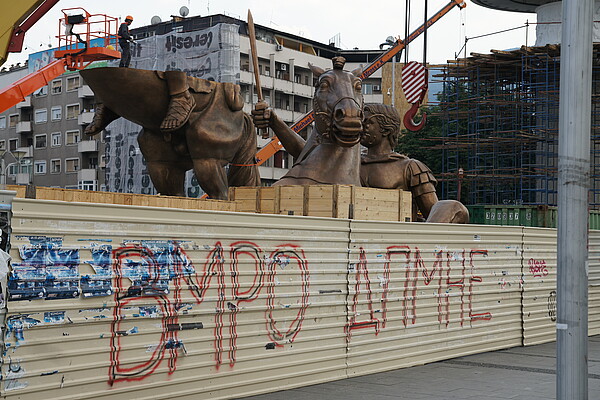
What does it take to change the identity of a city? It should be enough to erect a few hundred monuments of gargantuan dimensions, cast in bronze or carved in marble. If that does not suffice, a dozen grandiose new buildings should definitely do the trick. Of course, all of this should take place within a radius of 500 meters in the middle of the town and over the course of four or five years. To make sure that such a radical remaking will really be implemented so quickly, rigorous and time-consuming procedures of all manner are best avoided. If it takes some going around the legal regulations than that is not a problem. There really should be no problems at all; nothing should stand between the inventors / investors of the project and its realization. Moreover, this lavish expenditure of millions of public funds on the symbolic landscape certainly is not just for city beautification purposes. The city in question is the capital of a recently independent state, and the new construction addresses numerous problems that have arisen on the difficult path to independence. The following analysis focuses both on the remaking of the capital city as an effective means of changing the identity of a nation and on the unintended results of these efforts in a reawakened public sphere.
Before modernity came to Macedonia the region featured an incredible diversity of languages, religions, costumes and customs, or – to use a favourite formula – cultures. When modernity arrived in Southeastern Europe that diversity was redefined as an unbearable mosaic of peoples, ethnicities, and nations. After almost two centuries of unmaking this diversity, the Republic of Macedonia that emerged as an independent country after the collapse of the Socialist Federal Republic of Yugoslavia still has to deal with the pronounced diversity of its population. In a country of two million people just over 60 percent are Macedonian, mainly of Orthodox faith; around 25 percent are Albanian, mainly of Muslim faith; and the rest are Serb and Vlach (both Orthodox as well), or Turkish, Bosniak or Roma (which are mostly Muslim). Complicated power-sharing mechanisms have been introduced and in conjunction with the dominant discourse of ethnonationalism they have brought to fruition an ethnocratic regime. Since the collapse of Yugoslavia, Macedonia has become a country in which ethno-politics determine the social and physical boundaries between members of different ethnic groups. At the same time, it is a country that has demonstrated incredible resilience toward the perpetual confrontation between different 'national interests', as they are conceived by the dominant ethnopolitical elites, as well as resistance to numerous calls for ethnic violence made by more radical individuals and political organizations. Macedonia’s capital, Skopje is currently under full-scale assault by irresponsible ethno-politicians. The current building offensive, for instance, encompasses the entire centre of the city; its objective is nothing less than the total redefinition of Skopje’s image. Over a dozen new buildings designed in an eclectic mishmash of Neoclassical and Neo-Baroque styles are now being erected in and around the central city square and will completely change the cityscape. Even the façades of adjacent modern buildings are to be redecorated and adorned with Baroque ornaments. Over a hundred monuments and statues are currently being installed within a radius of one kilometer, none of them less than four metres high and the tallest of them, which is 15 metres high, perched on a pedestal that itself reaches 12 metres. The monuments and statues feature historical figures chosen for their value and utility in constructing a Macedonian national identity. Even a Macedonian Triumphal Arch has been built at the entrance to the city square. The central and tallest figure is that of Alexander the Great, who sits upon a rearing horse and brandishes a sword.
This symbolic reordering of the city has been accompanied by some narrative content as well. Two new museums have been opened. One, a national historical museum, offers an interpretation of Macedonia’s past that reflects the viewpoint of the ruling party. The other is, unsurprisingly, a national archaeological museum. The odder of the two buildings, it features an imposing façade and almost nothing behind it. It looks as if cut-out from some humongous building, but for the lack of space, and since only two metres separate it from the existing buildings behind it, it is best described as a façade. This description best captures the cosmetic nationalism of this newly invented architectural style. The long name of the neighbouring party museum aims to obscure that fact by pretending to be something of a more general purpose: Museum of the Macedonian National Struggle for Statehood and Independence and Museum of the Victims of the Communist Regime. As the ruling party claims continuity with the historical Macedonian Revolutionary Organization it has adopted this historical name and introduced anti-communist discourse as a practical political tool for isolating the political left as anti-Macedonian. With the opposition thus politically delegitimized, the ruling party enjoys an unchallenged claim to govern. The aggressive agonistic discourse that divides the nation between patriots and traitors has subjected the national historical narrative to a major revision, and this museum is one of the main instruments for ideological indoctrination. Thus, the total reordering of the capital city’s centre, which has been dubbed Project Skopje 2014, is not a mere beautification project, but has other, broader goals to fulfill.
Since 2007, Macedonia’s government has been persistently erecting cultural and administrative objects in the centre of Skopje; but the real character of this initiative did not become obvious until later, in February 2010, when the government promoted a six-minute video clip of computer generated images layered over the existing panorama of the city of Skopje and promoted it as their vision for the Macedonian capital in 2014. This proved that the project was motivated by more than mere functionality, i.e. the expansion of administrative office space. Dozens of new buildings in an eclectic historicist style now surround the central city square, which has been peopled by dozens of grandiose monuments cast in bronze or carved out of huge blocks of marble. The new image of the capital is oriented towards long-obsolete styles, with the intention of establishing links to an architectural heritage that never actually existed in Skopje. While the new buildings do house some cultural and administrative institutions, they most of all provide a new look for the Macedonian capital and a new identity. The time span covered by the newly erected and planned monuments is quite impressive. Statues of Alexander the Great (fourth century BCE), Emperor Justinian (sixth century CE), Tsar Samuel, Saints Cyril and Methodius and Saints Clement and Naum (tenth and eleventh centuries CE), as well as a number of Macedonian revolutionaries (from the sixteenth to the early twentieth century) provide the redefined national myth of Macedonia with a sense of continuity.
Compared with the sheer number and size of all the monuments that the current government is relentlessly installing, the monument to the great fifteenth-century Albanian hero Skanderbeg that was installed on the other side of the river Vardar in 2007 seems somewhat diminished. All these monuments erected by Macedonian and Albanian ethnocrats share at least two characteristics. First, they were installed to symbolize ethnic group identity and thus to mark territories. Second, their construction involved circumventing in almost every aspect existing legal regulations and procedures. Such a modus operandi is only possible in the state of emergency that the ethnocratic order constantly invokes with claims that "we are under threat", "we must assert ourselves, or perish", etc. In this world view, there is always a need for urgent action; there is always a greater goal that licenses the disregard for such petty procedures.
Images of the past have always been an important element in creating a vision of the nation. The way the state relates to the past has always been important, but in the case of “Skopje 2014” it becomes of paramount importance. The project "Skopje 2014" is not that much a project of preservation, or conservation, but rather the reconstruction of heritage and a peculiar invention of a heritage. It relates to the past with active production of intended heritage constructed in the present and thus this selective heritage production is tantamount to a "production of a selective tradition by the state system".[1] Further, rather than preserving an actually existing cultural and architectural heritage, this project introduces a style, the Baroque, that was altogether absent in Macedonia, alongside some version of Neoclassicism, which existed there only in a handful of authentic instances. The whole effort goes beyond architectural revival, a return to the styles of remote times and places. While “Skopje 2014” serves as a bridge to Western European civilization, it is also, an attempt to overcome five centuries of Ottoman rule. Like other de-Ottomanization projects so prevalent in the Balkans, the government’s selective approach to heritage protection[2] involves creating a wall of façades to hide the old part of the city and the soaring minarets of numerous mosques. The project also urges the inhabitants of Skopje to forget the Modernist period that dominated the reconstruction of the city after the disastrous earthquake in 1963 inasmuch as that style is a clear reminder of the achievements of socialism. The new rhetoric of the government, however, asserts that only bad things came from the hands of the communists who ruled the country from the end of WWII to the collapse of Yugoslavia in 1991. The new Skopje will have to look older and this has a purpose. Architectural revivalism is neither novel nor unique to Skopje, but this particular project is different in the timing of its implementation and in its shameless faking of architectural history, which has transformed the city beyond recognition. While the urge to establish, construct, or altogether invent links to past glories and ideals are not unusual in the world of nation states and practices for establishing and maintaining such political orders, such revivals have typically happened in past centuries, not in the this millennium. This anachronistic undertaking thus merits deeper and more thorough examination.
This project of remaking and inventing a country’s heritage is not as simple and straightforward an operation as its inventors perhaps imagined. On the contrary, it produces many contradictions, most of them not so unpredictable and fortunately, desirable. In a country that emerged from the brink of a civil war in 2001, aggravating already tense inter-ethnic relations is tantamount to careless, or at least clueless leadership. The installation of hundreds of statues and monuments with historical figures selected to stand guard over Macedonian national identity will certainly upset the highly politicized Albanian minority, which is ready to take offense even of the notion of being a minority and is in fact officially conceptualized in the constitution as "a group not in majority". Nevertheless, we must keep in mind that ethnonationalism is not just the favourite means of mobilization amongst Macedonian nationalists, but is the primary, if not only tool, used by Albanian politicians in Macedonia as well. As a result, the territory of Macedonia is dotted with national flags, national monuments, national memorials, and religious and other cultural markers of ethnonationalist division. This absurd logic of ethnically dividing the territory, which is particularly disturbing when applied to urban settlements, started decades ago but has now been brought to a climax with the project "Skopje 2014". The reactions to the project "Skopje 2014" and its divisive effects are countered by rejection of this logic by Skopje citizens who now actively seek for public spaces that are jointly used by diverse ethnic and religious groups.
Paradoxically, for the Macedonian nationalists who have been in power since 2006 and who are behind this project, the few historical Neoclassical buildings already existing in Skopje were a product of the Serbian colonization of Macedonia and the de-Ottomanization of the city between the two World Wars. These efforts during the Kingdom of Yugoslavia were aiming at overcoming the lag in architectural development by comparison with Western Europe, which had developed during the five centuries of Ottoman rule. It is worth noting that this process arrived late to Macedonia since it remained the longest under Ottoman rule. By the 1930s, when Skopje was being reshaped and new developments were taking ground more seriously, modernism was already in full swing and the city acquired a number of buildings that spoke a more contemporary language, like the Officers’ House, the National Bank and the National Theatre, and that were historicist and eclectic in style. The disastrous earthquake in 1963 erased these landmark buildings, all of which symbolized the Serbian-dominated state and which now serve as the foundation for alleged reconstruction of 'old' Skopje.
After the earthquake in 1963 Skopje was rebuilt as a modern city, with brutalist and even postmodern elements. The socialist renewal of the city was able to attach to and easily incorporate those modernist buildings built during the Kingdom of Yugoslavia that had survived. Now, we are witnessing the reintroduction of architectural styles from the eighteenth and nineteenth centuries, this time to cover up the modern period, which was allegedly favoured by communists due to modernist architecture’s lack of specific national features. Reviving the neoclassicism that had arrived late with Serbian colonization and their assimilatory efforts would seem to contradict the intentions of today’s Macedonian nationalists, who wish to stress Macedonian independence as deeply rooted in the past. The century-old project of the colonizers and the present-day nationalist reordering of the Macedonian capital nevertheless have one thing in common: the desire to overcome the distance to Western Europe.
The "Skopje 2014" project’s overemphasis on national identity seems to have provoked unpredictable counter-effects, both internally and externally. The essentialist reading of history that is characteristic for nationalist discourse demands the establishment of clear and undeniable national borders, both diachronically and synchronically. While the horizontal sanctity of national territory is difficult to achieve, the vertical mythic continuum of the nation in history is even more difficult to attain, yet it appears easier to attempt. Such integrity and coherence is especially difficult to achieve in the Balkans, where frequent and radical changes have resulted in the emergence of manifold cultural layers. To erase or even out the scars and marks of recurrent ruptures is not an easy task for any of the nation states in the region. The process of creating a history that leads straight back to antiquity demands a highly selective approach to archaeological and historical artifacts, the subject matter of cultural heritage. Therefore, the protection of cultural heritage in Macedonia should not be understood as a neutral and objective process, but as the very biased and instrumentalized field of the production of national narratives. Unfortunately, one of the most immediate effects this project has provoked is the further division of Macedonian citizens along ethnic lines, since those who are not members of the titular nation – namely Albanians, Turks, Roma, Serbs, Vlachs and others – have been left out of this grandiose nationalist narrative.
In a country as famous for its complex and long-standing diversity as Macedonia is, the application of this essentialist logic requires additional efforts. To create a uniform essentialist narrative in such a society is extremely difficult, as its profuse historical ruptures have sedimented in a richly layered history that includes fragments of earlier periods that stand witness to the frequent changes and mixing of cultures and civilizations. The entire Balkans shares this feature, and throughout the region the management of cultural heritage is a politically charged process.[3] The Macedonian case is the most recent and perhaps most spectacular effort to achieve both the horizontal and vertical axes of a national narrative at the same time and thus to demarcate a pure territory and define clear path to the origins of nationhood. "Skopje 2014" attempts to establish a new spatial order by way of selective heritage protection and intended heritage production by erecting new, but "old-looking" buildings and monuments. However, I would argue that the essentializing logic of the ethnonationalists has met its match in the intangible heritage created through centuries of turmoil and diversification.
A great number of Skopje’s citizens have refused to accept the imposed division of their city. The trails they create, the trajectories of their movement across the city has been changed in reaction to the project "Skopje 2014". Skopje’s Old Bazaar, the remnant of the old nucleus of the city, has suddenly become the most attractive place for night life. Cafes and restaurants have mushroomed in this long-forgotten part of the city. One of the best preserved Ottoman bazaars in the Balkans has become a magnet for those that disagree with "Skopje 2014" aesthetics and perhaps find the political narrative of a homogeneous nation simply wrong. They flock across the river to share the same space with fellow Skopje citizens of other ethnic and religious affiliations and take no offense at the public display of those differences. A new spatial pattern has emerged in reaction to the ethnocratic spatial order that divides the city and it resistance to the official, imposed narrative and spatial order inheres in simple acts of crossing those ethnic borders.
The meaning of the built environment has never been neutral, and it has been long established that its construction is always a political act and the expression of power relations. The recent attempt to create a historic Skopje, a capital city fashioned like those that emerged in the nineteenth or eighteenth centuries or even earlier, clearly confirms the central role of politics in creating cultural landscapes and heritage sites. We must not forget, however, that "history is embedded in the urban landscape of the city"[4], not just hanging in the museums. This urban history, despite the intentions of the project ‘Skopje 2014’, is multivocal, out of sync with it and even chaotic, but alive and constantly changing, not static and sterile like the bronze and marble statues. The street-level everyday perspective inaugurated by de Certeau[5] is forever going to haunt those great narratives of nationalism and other hegemonic discourses. The ‘Skopje 2014’ project and the one-sided, top-down version of history and heritage that it aims to produce clash with the multiethnic, multireligious and multilinguistic reality of Macedonia. Since its inception this project has become a textbook example of contested cultural heritage. Such 'heritage fabrication'[6] insists on the greatness of the Macedonian people, but Macedonia is a country with a multitude of ethnicities and cultures; so it seems that with "Skopje 2014" we are presented with a case of extremely bad diversity management.
Acknowledgments
This article is based on research fully funded by the Max Planck Institute for the Study of Religious and Ethnic Diversity in Göttingen, where the author was a post-doctoral researcher from 2008 to 2011.
It is composed of fragments of papers previously published by the author and adapted for this article by Juliane Tomann. The author has provided further commentary and edits to the text.
Goran Janev, What Happened to the Macedonian Salad: Ethnocracy in Macedonia, special issue South-East European (Post)Modernities, Ethnologia Balkanica 15 (2011): 33–44.
Goran Janev, Narrating the Nation, Narrating the City, Cultural Analysis 10 (2011): 3–22.
Goran Janev, Ethnocratic Remaking of the Public Space: Skopje 2014, European Federation for Landscape Architecture Journal 1 (2011): 33–36.
Goran Janev: Skopje 2014: Instrumentalizing Heritage for Unexpected Results. In: Cultures of History Forum (12.04.2015), DOI: 10.25626/0038.
Copyright (c) 2015 by Imre Kertész Kolleg, all rights reserved. This work may be copied and redistributed for non-commercial, educational purposes, if permission is granted by the copyright holders. For permission please contact the editors.
Blog by Ljubica Spaskovska The Battle for Skopje – urban citizenship and the legacy of the past
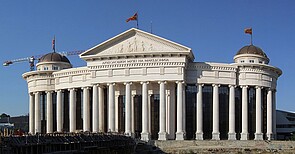
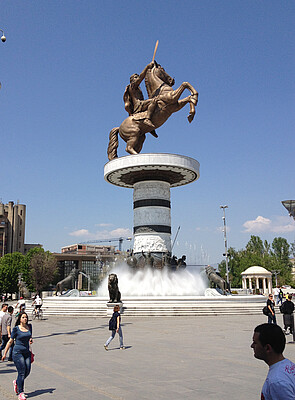
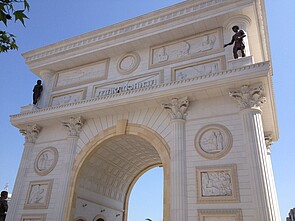
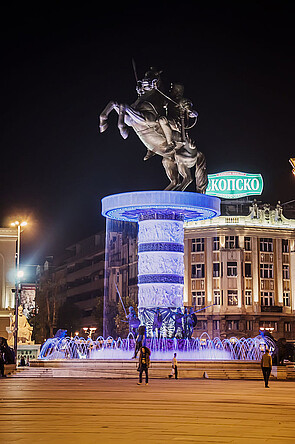
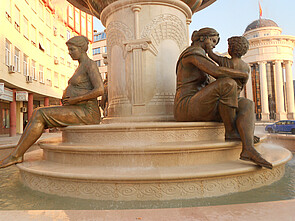
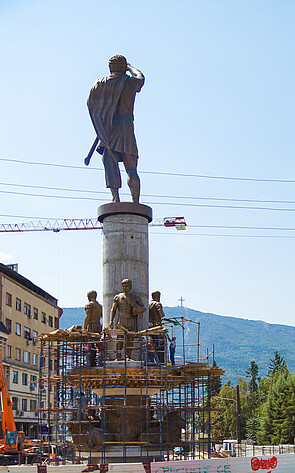
Naum Trajanovski · 20.06.2024
The “Skopje 2014 project” at its Tenth Anniversary: A Story of Resilience
Read more
Get this article as PDF download (including pictures).